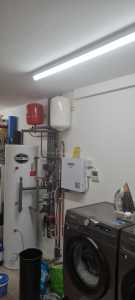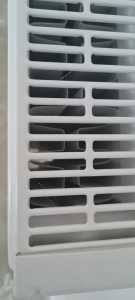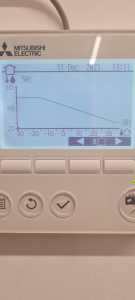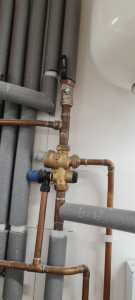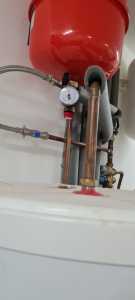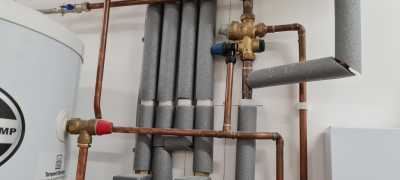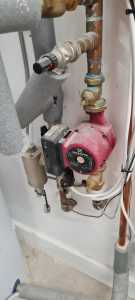11.2kW Ecodan in 182sqm property
Hi, thanks so much for all the information regards ashp, I have gained so much great knowledge.
I moved into new build 3 wks ago with a ecodan 11.2, property 182sq mtrs. very well insulated. Ashp installed by developer so no input into design and very very scant handover. Basically, leave alone, in the engineers words " set it and forget it" 🙄 well he isn't paying my electricity bill! so I came to the forum to learn how to use the system efficiently and economically.
So first thing was to reduce flow from 60c to 45c this reduced the cost from about £50 in first 4 days to £60 the following 7 days ( thats total electricity) now I have melcloud app I can track energy useage just for ecodan.
Secondly changed water temp from 50 to 47 and from normal to eco.
We keep system running 24/7 we have 7 room thermostats for ufh throughout downstairs and rads upstairs, we think they are K3 but not sure. We have a wireless controller for upstairs too.
I tried to reduce the flow to 40 but the rads didn't get very warm so I a have reduced flow to 44 and going to see if that makes a difference and then reduce incrementally until we feel a change in the comfort level. I'm "nesh" is that word only used in Yorkshire 😀, so like the upstairs 20 and downstairs 21degrees.
As its been such a steep learning curve ( no pun intended ) I'm leaving compenstation curve settings until weather gets a bit warmer, I understand the concept just dont know what to set it at yet.
My main question is we have water tank in garage and its freezing in there do we have to insultate the water tank?
Many thanks again for all great information, although at times it goes way above my head Im willing to learn.
welcome to the forum. Don't be afraid of weather compensation. All it does is change the flow temperature according to how cold it is outside. Even if you find 40C works one day, if/when it's colder that might not be enough to heat the house, even if your thermostats are telling the ASHP to keep heating.
Another point is that radiators don't have to feel that hot to heat the house, especially in a well insulated new build. They work mostly by convection, ie. warm air coming out the top rather than radiating heat from the front. Unless it's really cold, 40C heat my house very well. You need to try and forget the piping hot gas/oil heating radiators you're probably used to.
If you need help with the Ecodan settings please ask as there is a lot of knowledge here.
Thanks for that Kev M. Yeah the rads never get red hot, but when I turned it to 40 it struggled to get to 19 degrees upstairs no change with ufh. Thats why I'm going to check with the builder to see if the rads are K3. When we first moved in we had issues with rads as system had not been on, pressure had dropped so we had to realign pressure gauge on water tank and bleed them. Today it feels toasty warm at 44c but will keep lowering it, because I think I read for every 1 degree reduction we will save money. Also we have only been here 3 weeks we have no blinds/curtains or carpets so that will also be a factor, so glad to hear 40c is achievable.
Posted by: @sandThanks for that Kev M. Yeah the rads never get red hot, but when I turned it to 40 it struggled to get to 19 degrees upstairs no change with ufh. Thats why I'm going to check with the builder to see if the rads are K3. When we first moved in we had issues with rads as system had not been on, pressure had dropped so we had to realign pressure gauge on water tank and bleed them. Today it feels toasty warm at 44c but will keep lowering it, because I think I read for every 1 degree reduction we will save money. Also we have only been here 3 weeks we have no blinds/curtains or carpets so that will also be a factor, so glad to hear 40c is achievable.
Hi Sand,
Welcome to the forum.
Kev is perfectly correct, that for better efficiency you should be utilising weather compensation, though if your FTC controller is located in a suitable position you could use auto adaptation, which would keep the indoor air temperature more constant. They are predicting a warmer spell in the near future, so you could probably find that with weather compensation or auto adaptation the water flow temperature would be lowered to the mid 30's.
K3 radiators have 3 heating panels, K2, obviously two, so it should be easy to check what you have.
Do you have any heat loss calculations and do you know that total heating capacity of your radiators and UFH?
Do you have a buffer tank or low loss header?
If the radiators are the correct size and have been bled, but you are still not getting sufficient heat to the bedrooms, then it could be that your system is not correctly balanced. That is that you are not getting sufficient water flow to the upstairs radiators.
Hi Derek sorry no heat loss calcs system already in place when we moved in the epc rating was B. Other than that i wouldn't know where to start.
Not sute re buffer so see attached images, think rads are K2 then, size wise they look big. Not the most aesthetically pleasing rads but we hoping to change them in future will look for K3 now. They have all been bled and pressure gauge aligned.
This is our default compensation curve set by installers, what should we set it too. Because we still learning about the system we just reduced flow as that seemed the easiest thing to do, quickest win re economy as it had been set at 60.
Ta for help.
Hi Sand,
It is impossible to tell from the photo if you have a buffer tank or low loss header. It could be incorporated within the bottom section of your hot water cylinder. If you Google the manufacturer and model you should be able to find out the details.
Do you know if your system has been zoned?
Since your home should be quite well insulated, I would suggest trying a weather compensation curve of 50C water flow temperature at -10C ambient air temperature and 25C water flow temperature at 20C ambient air temperature. It is then a matter of monitoring the change in indoor temperature with changes in outdoor temperature, and making adjustments so that the indoor temperature remains reasonably constant with variations in ambient air temperature.
You will of course need to turn up your thermostats by 1C or 2C, so that they are not interfering with the weather compensation.
That tank, in fact pretty much that install is nearly identical to mine. My installers informed me no buffer or low loss header.
Retrofitted 11.2kw Mitsubishi Ecodan to new radiators commissioned November 2021.
14 x 500w Monocrystalline solar panels.
2 ESS Smile G3 10.1 batteries.
ESS Smile G3 5kw inverter.
Thanks for replies.
Yes Derek the system has been zoned zone 1 is downstiars zone 2 is upstairs. I'll have a go and will let you how the weather compensation changes go.
They look more like pressure relief valves. If you cannot identify an item of equipment then get the manufacturers name and model number and consult Dr. Google. If you are still not certain then send me the details and I will try to identify it.
The red item in the fourth photo is a water pump, which appears to be connected to the bottom section of the cylinder, it therefore may be the buffer tank.
There should also be a set of control valves for your UFH, and probably a 3 way diverter valve for DHW or Heating control.
- 26 Forums
- 2,364 Topics
- 53.6 K Posts
- 55 Online
- 6,029 Members
Join Us!
Worth Watching
Latest Posts
-
-
RE: Octopus Cosy Heat Pump Owners & Discussion Thread
@kevh it's worth remembering that many lsvs only actual...
By JamesPa , 13 hours ago
-

@majordennisbloodnok Education, Education, Education…
By Toodles , 16 hours ago
-

RE: Setback savings - fact or fiction?
Exactly. We only need to compare conditions, to decide ...
By cathodeRay , 19 hours ago
-
RE: Balancing financial efficiency and comfort using the Octopus Cosy tariff
I found because I have very low heat loss I can set bac...
By RadWhisperer , 22 hours ago
-
RE: Need Help Optimising My Rushed ECO4 Install: 12kW Bosch Heat Pump
Welcome @mickamills We too have an oversized 12kW Sa...
By Old_Scientist , 1 day ago
-
RE: My Powerwall 3 Consumes 3-4 kWh/Day in Self-Consumption: Is This Normal?
@caron I can confirm that the power usage of the PW3 is...
By Old_Scientist , 1 day ago
-
RE: Speedcomfort radiator fans
Thats true, but having tried (and succeeded) in constru...
By JamesPa , 1 day ago
-
RE: Solis S6-EH1P8K-L-PLUS – Why I Chose It and What I’ve Learned So Far
@bash brilliant, thanks for the feedback
By energy9165 , 1 day ago
-

RE: Heat Pump Heats the House… But It’s Not Cosy. Emitter Changes or System Tweak?
@alastair There I was, feeling grumpy, he said “Cheer u...
By Toodles , 1 day ago
-
RE: Grant Aerona: Is there a setting to keep the 2-port valve open during pump blockade
Depends on OAT. Mine cycles at OAT>10 and of course...
By JamesPa , 2 days ago
-
RE: New Fogstar 15.5kWh upright solution
@transparent My conclusion is as you have noted, tha...
By Bash , 2 days ago
-
RE: Mitsubishi Ecodan R290 10kW performance
And to you too. Wishing you a very enjoyable festive s...
By Sheriff Fatman , 2 days ago
-

RE: External pipework insulation
They do? But that isn't apparent from the photos we'r...
By Transparent , 2 days ago
-

RE: Say hello and introduce yourself
@velcro welcome to the forums. Please feel free start a...
By Mars , 2 days ago
-
Daikin EDLA11D3V3 DHW Settings
I have a newly installed EDLA11D3V3 which I'm still get...
By Velcro , 2 days ago
-
RE: Midea ASHP – how to set weather compensation
@curlykatie did you get sorted with this?
By MickaMills , 3 days ago
-
RE: MyVaillant Connect Regular Disconnect
Thanks. Yes, if the time is consistently 11pm every nig...
By buckwem , 3 days ago

